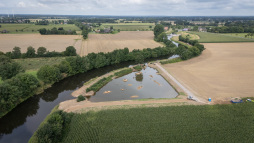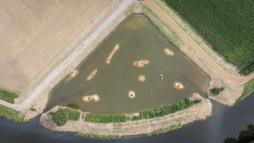
© Stadt Bocholt
The new retention area and cycle path in the Eisenhütte area
© Stadt Bocholt
The new retention area and cycle path in the Eisenhütte areaRetention area and new cycle path on the Bocholter Aa shortly before completion
City of Bocholt creates retention area and revises pathways
The city of Bocholt has implemented a rainwater retention measure in the area of the Eisenhütte weir. The neighbouring cycle path was relocated and rebuilt as part of the work. Final work on the area will follow in the coming weeks.
The aim of the measure was to retain excess rainwater before it was discharged into the Bocholter Aa. "We also upgraded the area ecologically", says Hermann-Josef Vogt from the waste disposal and service company (ESB) of the city of Bocholt.
To this end, an area in the direct vicinity of the watercourse was remodelled. The existing embankment was relocated to create space for a near-natural retention area. In conjunction with other ecological measures, this area will also serve as a resting and refuge area for plants and animals in future.
In the course of this work, the route for cycle traffic was also adapted. The existing path, which previously lay on the old embankment, was removed and rebuilt on the new embankment crest.
A material was used that had already proven itself on several paths in the Bocholt city area. The new cycle path consists of a water-permeable, mineral mixture of materials produced in the Dutch border region. A mineral mixture with a grain size of up to 6 mm was installed and statically compacted. The material is made from regional raw materials," explains Sven van den Berg from ESB.
The path was built on a compacted surface. The red ash from the old path was mixed with the new gravel; separate disposal was not necessary. The chosen construction method provides a stable, tread-resistant surface and at the same time ensures that rainwater can seep away. The light colouring and natural appearance blend in well with the surroundings.
The work is due to be completed in September. The new area will then be opened to the public together with the retention area on Uhlandstrasse and the newly designed Sandbachpark, according to Vogt.


